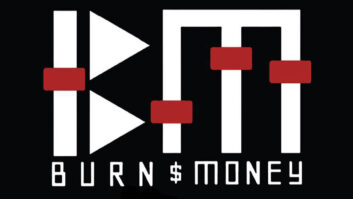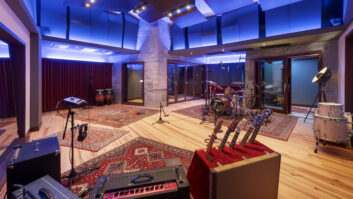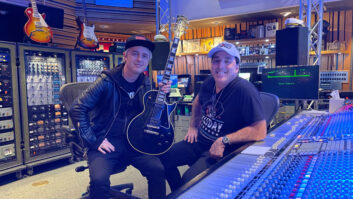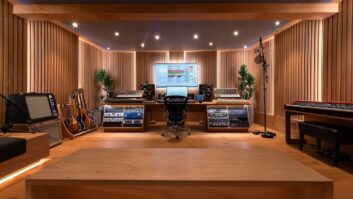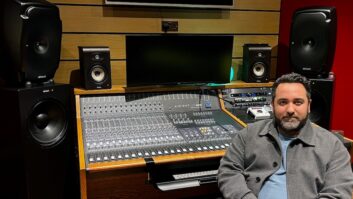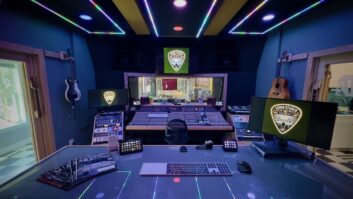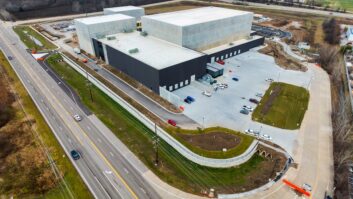

Snow is falling on Weed, the tiny logging town at the foot of Mount Shasta in Northern California. Inside a 90-year-old structure formerly known as the Weed Palace Theater, Sylvia Massy Shivy is proudly showing off her rare, vintage and downright weird gear.
Massy Shivy has a long résumé; she has produced, mixed and tracked the likes of Tool, System of a Down, the Red Hot Chili Peppers and Johnny Cash. Today, she is the owner and chief staff producer of RadioStar Studios, located in the Weed Palace on Main Street, in a town with no stoplights. Seven years ago, she was the hot hand on the faders around Southern California studios. After several albums she produced went Platinum, she was in demand by bands wanting that big sound and labels seeking that big paycheck. So why did she decide to leave the bright lights and head north to a quiet mountain town that sounds more like something you smoke than an actual city?
“When I left L.A., I had a little house with half a yard in West Hollywood,” Massy Shivy explains. “I would sit in traffic all day. I would drive a long way to work in a studio that I was never really happy with. I wound up dragging racks and racks of gear into studios just so I’d have what I needed, because no studio was set up the way I liked it. I was ready to leave.”
She bought a four-wheel-drive Jeep in anticipation of a move to the mountains near Lake Tahoe, an area very much like the place where she grew up in Colorado. But fate intervened and she met Greg Shivy on a family outing to Mount Shasta in 1999. The couple married in 2000, and a year after moving to the mountains, they discovered and bought the vacant Weed Palace Theater for a fraction of what a similar property would have cost in L.A. “In fact, my car cost more than this building,” she says. So she loaded up her gear and moved up to Weed.
Nearly five years later, RadioStar is a full-fledged hard-rock Mecca, where the perks are clean air, abundant spring water, wide-open spaces and a 14,000-foot snowcapped giant right outside the front door. It’s a studio, a record label, a video production company, a merchandising outfit and an equipment manufacturer. It’s the successful fruition of Massy Shivy’s vision of getting musicians, artists and engineers to leave behind the urban sprawl to live, play and record together without a lot of distractions in a beautiful, inspiring location.

On a February visit to RadioStar Studios, people are busy moving lighting gear, draping the stage with a white backdrop and preparing for a video shoot. A 20-foot-high sculpture by artist Finley Friar dominates much of the room. It’s a manlike figure named “Stan” made from vinyl records and colored vinyl that is lit up from inside. The room has theater seating for 600, Egyptian art deco styling on the walls and ghosts from another era.
“There’s fantastic natural acoustics in here,” Massy Shivy says of the spacious theater, which is now RadioStar’s Studio A. “It has 30-foot ceilings, and the floors are local-milled hardwood. What makes it special is that it was originally designed for vaudeville and there was no amplification then. They designed it so you could whisper onstage and the people in the back of the room could hear it. So you can’t talk shit about bands when you’re working in here. We removed the back row of seats and put in the Neve. The console is completely open. When we track drums, we wear headphones. We left most of the seats and are retaining the theater because we want to reopen as a live venue.”
The console is a classic 8038 Neve featuring Neve 1073 EQ modules. It was built in 1972 specifically for CTS Studios in London, where it lived until Massy Shivy bought it and moved it to L.A.’s Sound City in the mid-’90s. There’s a subfloor beneath the theater seating, and tielines run under the floor from the stage to the back of the room where the console resides. Bands set up onstage and play with headphones and individual Furman headphone mix boxes. Engineers back at the console also wear headphones when tracking the performers onstage. Everyone removes headphones when they’re doing overdubs and mixing.

“It’s really like playing in a live venue, a really good live venue,” Massy Shivy says. “There are catacombs under the stage that we have set up as iso rooms for speaker cabinets. We have speaker tielines that go under the floor back into the catacombs where the cabinets are. We just have the amp heads up here near the console. If we want to use combination amp/speaker units, we can put the combos in various places for isolation. We can use the projection booth or the lobby. Actually, we use every inch of this place. We set up drums in the kitchen last week. We did vocals in the bathroom.”
RadioStar is an analog/digital hybrid when it comes to tracking. There’s a combination of Pro Tools systems and good ol’ analog tape recorders: a Studer A820 in Studio A and a Sony JH-24 in Studio B. (More on the B room below.) There are three sets of monitors in Studio A: big Genelec 1038s, custom-made NHTs and the standard Yamaha NS-10s. Studio B has Genelec 1031A and Yamaha NS-10 speakers. In her 20 years of recording, Massy Shivy has acquired hundreds of pieces of outboard gear, ranging from the unusual to the sublime. (Visit www.mixonline.com to learn about her rare and unique toys.)
ROOM FOR EVERYONE
Due to overwhelming demand, the Shivys built a second room a couple doors down from the Weed Palace/Studio A in 2003. Studio B is also loaded with vintage recording gear. It features an Amek/TAC Matchless console and a Neve BCM-10 sidecar, which also has the classic 1073 EQs and 1272 amps. The Amek/TAC console is mainly used for monitoring, and the Neve BCM sidecar is used for tracking and mixing. Because so many bands had to be turned away in 2005, there are plans to build an SSL-equipped Studio C in a dancehall farther down Main Street.
Bands travel from all over the globe to work at RadioStar, often booking a studio for two months at a time to work on an album project. Australian band Spiderbait came to RadioStar in 2003 and recorded their Tonight Alright album for Interscope Records. That album included their remake of the Leadbelly song “Black Betty,” which became a huge hit and climbed to Number One on the Australian charts. While we were visiting, an all-woman band from Norway called Furia were busy working in Studio B. Other acts that have traveled up the mountain to work at RadioStar include Dishwalla and Seven Mary Three, and renowned rock producer Ross Robinson recently brought in hard rockers From First to Last to record their latest for Epitaph Records.

FROM COLLEGE RADIO TO PLATINUM ALBUMS
Massy Shivy got her start in audio production at a college radio station in Chico, Calif. She then moved to San Francisco where she honed her craft as an assistant engineer at Starlight Studios and various studios around the Bay Area. She credits Matt Wallace as an early mentor in the art of tape alignment, microphone placement and mixing. When she first moved to L.A., she worked at Tower Records on Sunset Boulevard. That’s where she first made connections with bands Green Jelly and Tool. She considers Rick Rubin to be the most influential person in her career as a record producer, even though many of her greatest commercial successes as a producer (like the Platinum-selling albums by Tool) came before her work with Rubin.
These days, Massy Shivy keeps her ears fresh and mainly produces acts. “I used to do everything — produce, track and mix,” she explains. “But it’s much better to just be the producer and to have someone else set up the sounds. The guys I work with — Rich Veltrop and Kale Holmes — we’ve worked together for several years now. So they know exactly what I want. So they’ll dial it up. I still do a lot of engineering on vocals because I can get really intimate with the singer to get the right performance that I want.”
Not only does she have extensive microphones and outboard gear, Massy Shivy often uses “psychological processing” on the artist to elicit the appropriate vocal performance for each song. “Making them comfortable gets one result,” she explains. “Making them uncomfortable gets another result. Sometimes being uncomfortable is good to get an edgy performance. Also, the strange thing about being here in Weed is it’s isolated. There are only 3,000 people in this town. There’s no distractions here. Issues come up in people’s lives and they have to deal with it. There’s emotion that comes out of that. There’s nothing to cover up any raw nerves. So it can be very, very good.”
Massy Shivy has a knack for working with unknown bands and then watching those bands blow up to major-label stardom. “I’m looking for originality of sound and style,” she says of her criteria for choosing which acts to produce, “something that gives them a really distinct identity. I prefer to work with those people instead of working with the latest, greatest sound.
“It’s funny being a producer because the record companies come to me because they want something that they can market commercially,” she continues, “but in reality, my biggest commercial successes have been with artists that don’t fit that mold. Like Tool — there’s not much commercial about them with their 10-minute songs. System of a Down — there’s nothing commercial about them, though they are more commercial now than when I worked with them. It was very surprising for either Tool or System of a Down to get on the radio at all. Because I seek out bands with originality, that’s where as a producer I have to decide if I want to mess with a band’s sound. I don’t want to make them into something they’re not. So I think I’m really good at knowing when to say, ‘Leave it. Don’t touch it.’”
Massy Shivy wants to help bands get to a major label. When bands record at RadioStar, they not only get excellent recordings, but also electronic press kits and merchandising, and they may even be on RadioStar’s label, National Recorder, which is distributed nationally by Universal through Fontana. “I recognized the need for a label like this,” she explains, “because the majors aren’t doing artist development anymore. We’re here just to help the band move to a bigger market with a major label. I just saw that not happening for some of these great records that were recorded here at RadioStar. So we’re trying to help with basic artist development.”
RadioStar also gives opportunities to local kids to get them interested in music and recording, and to get them away from methamphetamine, which is a big problem in the area. “Any kid who wants to come here and sit in on sessions, we’ll make an arrangement for them,” she explains. “In fact, one kid, his name’s Cecil Gregory, is on staff now. He’s not even finished with high school yet, and he’s the fastest editor [on Pro Tools] out of everybody. He’s crazy good. We have another five kids who come here. They have their own day, and they have their duties list. So we give them something to do, and we give them the opportunity to see what’s going on.”

This fall, Massy Shivy will expand RadioStar’s commitment to next-generation engineers by opening the National Academy of Entertainment Technology (NAE-Tech), a trade school offering courses in audio recording, music business, live sound reinforcement and video production. Specialized instruction in rock music production, running an independent label and high-tech music marketing are planned. She’s also helping young bands with the development of National Roadshow, a touring company designed to provide custom-designed touring rigs for artists on tight budgets.
With so much talent, enthusiasm and energy, Massy Shivy is much more than a producer who owns a recording studio, and she has big plans for the little town of Weed. “You only live once,” she says. “I’ve been doing a lot of producing, and I’ll continue to do music producing. But there are a lot of other things I want to do, as well. Like my record label. Doing video. Merchandising. Then there’s the whole line of guitar pedals and rack gear. We have plans for a recording school and the live venue after we renovate the theater. And what else — I’d like to make root beer!”
Jeff Forlenza is a freelance writer in Oakland, Calif.
Rare, Vintage and Weird
We asked Sylvia Massy Shivy to describe some of her most unusual pieces of outboard gear. We only have room here for a select few items; there’s much more to check out at
www.mixonline.com.
This is the collection of gear that I’ve acquired from 20 years of digging around boxes in basements and stuff. I have hundreds of nice pieces of rack gear: compressors, limiters, effects, EQs — really unusual things — that I’ve used in recording music.
RCA BA-6A Compressor
During the early ’90s, I was determined to find a Fairchild 670 compressor stashed in the basement of some obscure radio station somewhere — that elusive golden discovery we all dream about. I got the Broadcast Yearbook and began calling every radio station in the country, asking if they had any “old worn-out analog equipment gathering dust.” Unfortunately, I never did find a $300 doorstop Fairchild. (I wound up paying a pretty penny for my 670 several years later.) But I did find the most incredible load of $100 compressors, including Gates, UAs, Collins, Altecs, CBS’ and RCAs. This RCA BA-6A was the cream of the crop. An excellent choice for vocals and acoustic guitar.
Pultec EQP-1a EQ
The most-copied EQ design around. Big, simple and right to the point. Excellent on kick drum and bass guitar, and surprising on vocals.
American DR332 Ribbon Mic
Makes everything sound deep and old. Excellent for effect vocals.
Acoustic Tuned Tube Guitar Amplifier
The weirdest guitar amp I’ve ever seen. It uses adjustable wooden panels to deflect the sound. Called the “Tuned Tube” not because it is full of tubes — in fact, it is a solid-state amp — but because it is built around a tubular structure with a speaker on each end pointing outward. The amp does sound unique, and has an excellent deep tremolo and spring reverb. I pulled this down out of the attic at the legendary Chicago Store in Tucson, Arizona, in 1994. I think it is an early design by the Acoustic company that went on to make those great bass amps in the ’70s.
Roland Vocoder
Originally designed to combine vocals with keyboards for a robotic sound. We like to combine vocals with guitar for an entirely different effect, or drums and guitars, or combine whatever with whatever!
Hammond C-3 Organ
I can’t believe this beautiful, pristine Hammond was sitting in a thrift store in Yreka, California. In absolute perfect condition, it had been pulled out of the local church and put in storage for nine years before the church finally donated it to the thrift store. With its original stool and complete service record starting in 1961, we could not have asked for a finer instrument.
1920s National Triolian Steel Resonator Guitar
This thing is so old, and is so wise. It starts talking to you the minute you pick it up. It tells tobacco-filled stories of hot sticky summer evenings on the front porch. Crickets chirping — hell, there’s probably crickets living in this thing! The main character instrument from Spiderbait’s hit song “Black Betty.”
Trixon “Speedfire” Drum Kit
Made in Germany in the ’50s, this drum kit has an array of five bongo-sized toms mounted backward to most traditional kits. And the “melted” kick drum is that way for a reason. The bass drum is actually divided into two acoustically tuned chambers and is played with a double-kick pedal. The world’s first double-kick drum! The Trixon company later became today’s Sonor drums. It took several years of searching, assembling and restoration for me to come up with these drums. Jim Keltner gushed over this kit after playing it at the Village Recorder on a session, making it worth all the effort.
— Sylvia Massy Shivy

